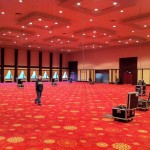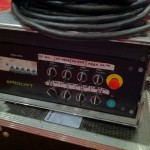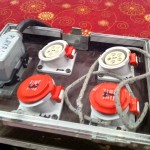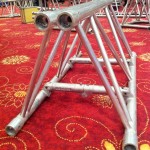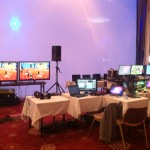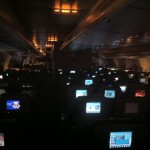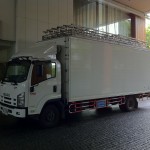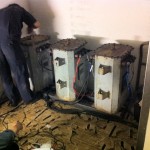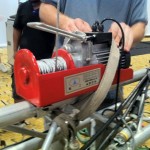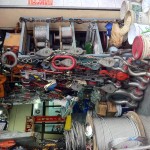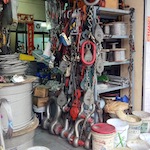Ayrton NandoBeam-S9 Demo Show with 41 Units
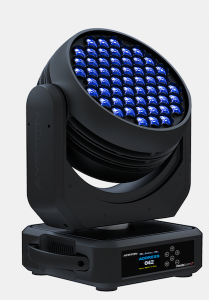 Who doesn’t love a good light show??? There is something magical and special about a well designed and executed light show to demonstrate a new light. I have always been impressed with the light shows that Ayrton has produced for online viewing as well as in person at trade shows. They go all out!
Who doesn’t love a good light show??? There is something magical and special about a well designed and executed light show to demonstrate a new light. I have always been impressed with the light shows that Ayrton has produced for online viewing as well as in person at trade shows. They go all out!
Sure, you can do some pretty impressive shows/demonstrations with a handful of the same light. Not for Ayrton, they go for the super-mega WOW factor. Their latest video proves that you go big, or go home.
Ayrton’s latest light show demo video features 41 of their latest LED moving head, the NandoBeam S9. Yes, 41! The lighting design and concept came from Stéphane Migné. While there is no mention, I assume this is was filmed in Ayrton’s demo room in Longjumeau, France, about 15 miles south of central Paris.
Here are some details about the Ayrton NandoBeam S9:
NANDOBEAM S9 luminaire is the latest development and the most powerful fixture in the NANDOBEAM product line. Equipped with a new-generation power supply offering over 95% total output efficiency, this power feature enables the highly compact luminaire to use its LED sources continuously at full power without any loss of performance.
NANDOBEAM S9 is equipped with fifty-five high-performance Osram 15 Watt RGBW LED emitters arranged in rings around a central LED which is independently controllable to give a multitude of graphic effects possibilities.
For more details, visit www.ayrton.eu. Contact Morpheus Lights, the Exclusive US Distributor of Ayrton, for demos and sales.
Martin Announces P3 System Controller Avilable in PC Version
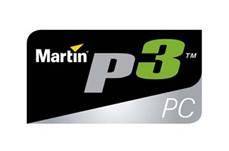 Martin Professional’s P3 System Controller for LED video screen processing is now available in a PC-based version. The P3-PC is an inexpensive yet full-featured software-only version that can control up to 20,000 pixels using the Ethernet port of the PC it is running on. This addition to the Martin family of P3 System Controllers packs three functions into a single software package:
Martin Professional’s P3 System Controller for LED video screen processing is now available in a PC-based version. The P3-PC is an inexpensive yet full-featured software-only version that can control up to 20,000 pixels using the Ethernet port of the PC it is running on. This addition to the Martin family of P3 System Controllers packs three functions into a single software package:
- A PC-based P3 System Controller for smaller Martin LED video setups containing up to 20000 pixels (P3-PC License on Martin One-Key™ required).
- An offline editor for the P3-100 and P3-200 System Controllers to preprogram setups anywhere on your own PC or laptop. Save and copy shows to the P3-100/200 using a USB stick (no license required; free-of-charge).
- A tool to address/test/upload firmware LED video setups on site before the P3-100/200 arrives on location (no license required; free-of-charge).
- The P3-PC software can be downloaded for free from the Martin Professional website. Media playback is performed by the PC itself using any media player application including Quicktime, Windows Media Player or VLC (Media playback requires an inexpensive Martin One-Key license.)
P3 System Controllers feature scaling and de-interlacing with a minimum of latency, unrestricted mapping of any screen element, real-time control of all screen parameters including brightness and mapping, robust video data distribution via Gigabit Ethernet, and an intuitive user interface. The P3-100 and P3-200 allow full integration with lighting control via DMX512. Users can treat LED screens like lighting instruments with direct cue-by-cue control of brightness, image rotation and position, color temperature and more. For applications requiring integration with motion control, the P3-100 and P3-200 also work with the Kinesys K2 motion control system to automatically adapt LED panel positioning in real time.
For more information, visit www.martin.com.
Review: Wybron Cygnus VN100 LED Fixture
 I knew Wybron was launching a new light- some articles can be found here, here, and (of course) here. I remember seeing it at LDI last year, but to my fault I passed it over. I was not prepared for the light that I pulled out of the box that UPS handed me.
I knew Wybron was launching a new light- some articles can be found here, here, and (of course) here. I remember seeing it at LDI last year, but to my fault I passed it over. I was not prepared for the light that I pulled out of the box that UPS handed me.
Spec wise it’s got it goin’ on. At full on it pulls 105w with 12 RGBW LEDs pumping 2205 lumens. The built in color correction has a beautiful range from 7000k all the way down to 2800k. The optics have a set beam angle of 13° and a field angle 25° and 4 lenses to choose from (narrow, medium and wide floods, plus an elongated lens) to modify the beam. Data connects through 5 pin DMX, is daisy chain-able and RDM compatible.
Four profiles give you a range of usability from 8 and 16 bit color mixing to the option of a white LED or an intensity master. The built in strobe functions are impressive and could very well rival actual strobe fixtures out there. Probably one of the coolest features on this light is the high speed mode which is optimal for HD recording (see below).
The first thing I noticed about the light was its construction. It was a bit bigger than I expected at 10″ long and 6.5″ wide- about the same size as a Source4 PAR with a clamp. The housing is constructed from aluminum and at just over 9 pounds I didn’t feel like it was going to break in my hands like a lot of new LED fixtures I’ve used. The tilt knob was also large and sturdy feeling allowing me to crank down on it without the fear of cross threading. I was very happy to see a dedicated loop for a safety cable attached right to the fixture.
The next thing that caught my eye were the LEDs. All 12 of them. All integrated RGBW units. All very blinding (I may or may not have peaked down the barrel while it was on). The dimming on the fixture has 3000:1 ratio and is comparable to an incandescent light. The next obvious thing to do is to test the throw of those very blinding LEDs. Since I didn’t really have a stage at my disposal, I used the next best thing: The apartment building across the street.
The distance of the garage to the third floor windows is close to 75 feet, if not more. And it punched. The color and intensity were bright and crisp. After putting the lenses in I was impressed with how little they cut the output and still flooded out the light. Shadows, both multiple and rainbow, were minimal at most.
For the quick and dirty there are a couple of cool stand alone features like 8 recordable scenes and a master / slave configuration.
The only downside for me is it’s rated at IP20 so that means dry indoor locations only. This is a bit of a bummer for me since I do a lot of outdoor work.
What I thought I was going to review was a small fixture meant for display installations. I was mistaken. Big time. I was given a light that I’m sure will give a lot of conventional wash fixtures a run for their money. From the smooth Dimming of the LEDs all the way to 0 and a strobe that would make any rave the place to be this light packs some serious heat in a small package.
The Cygnus VN100 has an MSRP of $1,547. The Cygnus family also comes in a VN200 and MF200 model at 200 watts and very narrow and medium flood respectively.
Do I really have to give this thing back?
[nggallery id=108]
Squint Abroad – Load In
Loading in any event can be stressful. Even when you are not dealing with language barriers, unfamiliar electrical standards, and different gear, the ballet of people and gear is a delicate balance between executing “the plan” and adapting to challenges. In a foreign country this process has the potential to be a disaster. Luckily, my experience abroad has been nothing but positive. This week we are in Istanbul, Turkey building, running, and then tearing out a corporate event. Although our client will only spend around seven hours in the general session space, countless hours have been spent planning, designing, building, teching, and rehearsing every little detail.
Let’s talk about the load in experience. I’ll paint you a picture of what exactly we are working with
- A ball room space (width) by (length) with a (height) ceiling.
- An octagonal 8 screen projection setup, with a “T” shaped stage at the front
- Lighting and seven speaker surround audio support
Fortunately for us the in house A/V is a production house similar in capability and gear to our own company. While we have traveled with our entire video rig, including switching and projection, the audio and lighting gear came from the house. They were able to provide familiar Vari Lite 3000 fixtures, ETC Source 4’s. Our audio team was happy to have the same Yamaha console we use back in the states, as well as a pair of Labgruppen line array cabinets. Eight powered speakers hide behind each screen for full surround audio support. Perhaps most importantly they were able to provide the proper truss (Prolyte folding triangle) and motor package. This show relies on the 18 foot tall video walls in an octagonal shape, and being able to fly the rig instead of ground supporting is a huge advantage.
Working with the in house team was a breeze. They know their gear well, and could easily take our CAD drawings and implement without a problem. While we had issues with language barriers enough of their crew spoke English well enough to keep both of our production teams on the same page. Needless to say, it was a great opportunity, and we are all really excited for the next chance to work overseas!
Squint Abroad: International Event Production, A Fresh Perspective
Let’s start from the beginning. I work for a live event production company based out of Indianapolis, Indiana. One of our clients is staging their annual general managers conferences around the world, and has been kind enough to ask us to leave the US borders and come with them. Our first stop is in Bangkok, Thailand. We left on the 28th of February, and returned to the States on March the 11th.
The flight(s) from the US, specifically Chicago, to Asia are forever long. I have to believe that the country is pretty much as distant from the Midwest as any could be. After a 14 hour flight from Chicago to Incheon, South Korea, we boarded a five hour flight to Bangkok. After a brief stint at customs, our crew of 15 was on it’s way to our home for the next two weeks; the Millennium Hilton Bangkok.
So that’s the surrounding story, but let’s be honest with ourselves. You came to iSquint.net to hear about event production technology. The truth of the matter is that while production gear is hardly scarce in this country, it can be incredibly expensive to rent for any short period of time. After choosing a gear provider and looking over the associated rental costs, we determined it would be more cost effective and reliable to ship our video equipment from the US. This particular show design calls for eight 16′ x 24′ projection surfaces surrounding the room. It creates the effect that you are in a 16′ tall octagon, with video painted seamlessly across all surfaces.
Lighting Gear
The lighting team was able to get their hands on a number of Martin Mac 2k’s, as well as multiple unbranded non-moving head LED fixtures to use as uplighting. It should hardly have been a surprise that all of the Martin gear arrived in PRG branded cases. Those guys truly are everywhere. Front light for the stage came in the form of what appeared to be brand new Phillips Selecon series fixtures. Everything was controlled by an Avolites Pearl console.
Video Gear
As mentioned above, we were able to ship all of the video equipment from the United States. Projection included a mix of four Panasonic 10k HD projectors and four Christie 10k HD’s. These pieces of equipment are available in Thailand, but the cost of renting 8 of the 20 available HD’s in the country is quite a bit higher than we were comfortable with. All screens were fed with a brand new Lenovo laptop running the Dataton Watchout’s most recent software release. We have been using Watchout a lot lately on shows, and despite a few fall set backs, we have had a lot of luck with the system. It has certainly given us the ability to create visual effects that cannot be easily mastered with tape decks alone.
Power
The power situation in the hotel ballroom was less than perfect, but they staff worked to make sure we were able to hook up our equipment without seeing the magical blue smoke. While the solution was a little scary looking, the equipment worked perfectly all week. Thailand runs on the 240V, 50Hz standard, where as your standard American Edison outlet hovers somewhere around 120V at 60Hz. Fortunately most of our gear, projectors aside, could automatically sense and handle the switch. To be safe, we ended up placing all of the video equipment on 120V, 60Hz service.
- The Journey
- Production Equipment Arrival
- Power Transformers
- Winch Hoist
- Watchout Production Setup
- Rigging Supply Shop
We have a week and a half back in Indiana to regroup, after which we will be taking the same corporate show to Istanbul, Turkey. Stay tuned for more stories, equipment discussions, and tips/tricks for international event production in the near future.
Barco Releases Digital Cinema Projector Designed For Post-Production
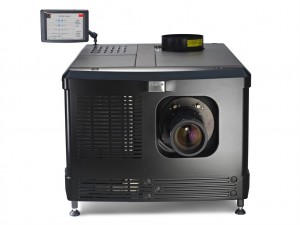 Barco has announced the commercial release of its DP2K-P, a digital cinema projector specifically designed for the needs of the post-production community. Featuring a greatly expanded color gamut, superior contrast, exceptional brightness uniformity and specialized post-production software, the DP2K-P effortlessly meets the stern performance demands of post-production houses as well as the review room requirements outlined in the DCI specification.
Barco has announced the commercial release of its DP2K-P, a digital cinema projector specifically designed for the needs of the post-production community. Featuring a greatly expanded color gamut, superior contrast, exceptional brightness uniformity and specialized post-production software, the DP2K-P effortlessly meets the stern performance demands of post-production houses as well as the review room requirements outlined in the DCI specification.
Barco’s new DP2K-P projector elaborates on the proven platform of its successful DP2K B-series, from which it adopts highly-praised benefits such as optimum light efficiency, lowest cost of ownership, and user-friendly operation. The DP2K-P integrates Texas Instruments’ 1.2” DLP Cinema® chip – a forward-looking choice for 4K compatibility. To prevent dust from intruding in the chip, the projector has been fitted with a patented, hermetically sealed enclosure, which guarantees undiminished brightness and contrast levels over the years and allows for the use of reusable air filters.
Barco’s new post-production projector comes with a special version of the company’s Communicator software package, enabling users to meticulously create and customize their 2D and 3D look-up tables. Thanks to this increased control over the color space, post-production professionals will experience an unprecedented level of accuracy.
Ken Billington Talks About Lycian’s 1250KB Followspot at Super Saturday 2011
I’ll let Mr. Billington and Steve Lerman talk about this one. You can learn more about the Lycian 1250KB Followspot by visiting their website at www.lycian.com. Thank again to Scott Parker and Sonny Sonnenfeld for permission to record this interview at the Stage Seminars Super Saturday.
Martin Professional Releases Maxedia 4.40 Software
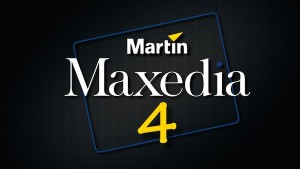 The latest software release for Martin’s user-friendly Maxedia™ media server brings the Maxedia feature set to a higher level. Aligning simplicity of use with complexity of execution, Maxedia 4.40 shows how the most powerful media server on the market can also be a user-friendly one.
The latest software release for Martin’s user-friendly Maxedia™ media server brings the Maxedia feature set to a higher level. Aligning simplicity of use with complexity of execution, Maxedia 4.40 shows how the most powerful media server on the market can also be a user-friendly one.
Highlights of Maxedia version 4.40 include:
Cuelist: Similar to lighting consoles, Maxedia now features a cuelist for automation. From simple drag and drop of cues through an intuitive user interface, cuelists are quickly built and ready to play back. Cuelists can be triggered manually, automatically using Wait and Follow time, or even using external timecode. This makes Maxedia the perfect media server for permanent installations as well as large events.
Timecode: Complementary to the new cuelist is new timecode input. MIDI and SMPTE timecode can be used to synchronize one or multiple Maxedia systems together. Not only will Cuelist cues be triggered at the right time by following external timecode but the actual video content of cues will also follow timecode. This means that video playback is exactly where it is supposed to be when the user jumps forward or backward in the timecode.
Up to 8 HD inputs: The Maxedia engine now supports up to 8 HD SDI inputs simultaneously. Using the newly added MCC capture card, latency is kept as low as 2 frames per second, turning Maxedia into a super powerful video switcher. In addition to the high speed capture, the video input can make use of frameblending for smooth 50/60 HZ conversion, a unique feature of Maxedia. A choice of Dual HD-SDI and Dual DVI MCC capture cards is available from Martin Professional.
New Output remapper: When using several video walls and creative LED video curtains there comes a time when breaking, scaling, rotating and repositioning the engine output into sections is necessary. This task is easier than ever with the new Video Output Remapper. A portion or the entire video content can be sliced and diced anywhere on the actual video output.
More 3D warping and Keystoning possibilities: Keystoning, edge-blending and 3D warping are now available on both engines, which makes each server really act like two servers. 3D warping in combination with keystoning and edge-blending can be done over six video projectors using a single Maxedia Broadcast and up to three projectors on a Maxedia PRO and Compact. Large scale projections onto buildings have never been easier or more cost effective!
A bundle of new creative effects: A dozen new, high-quality effects and plugins have been added to Maxedia 4.40. All the new effects allow for more control and better tools for the ultimate creative mind. Included is Framing borders, Chainer, Color Motion, Sepia, Advanced Chromakey and more.
For more information and to download the new Maxedia 4.40 software, visit www.martin.com.
Barco launches Rear-Projected Dome Technology and 10 Megapixel Simulation Projector
 Building on the expertise gained with liquid crystal on silicon (LCoS) display technology, Barco took the next step up in projection to remain at the forefront of simulation technology in terms of projecting the most realistic imagery available. This resulted in the SIM 10 projector, which offers a 10 megapixel (4096×2400) resolution, making it the only projector of its kind currently in the market for flight training.
Building on the expertise gained with liquid crystal on silicon (LCoS) display technology, Barco took the next step up in projection to remain at the forefront of simulation technology in terms of projecting the most realistic imagery available. This resulted in the SIM 10 projector, which offers a 10 megapixel (4096×2400) resolution, making it the only projector of its kind currently in the market for flight training.
The SIM 10 projector is the imaging heart of another Barco innovation, the 360° rear-projected dome. Designed from the ground up by Barco, including all mechanical components and screens, the dome offers a contrast of 25:1 and an average resolution that is always better than 4 arcmin/OLP. It is a customizable design, and fits into rooms as low as 14 feet high.
United Visual Artists D3
 Visual media has become more and more a standard over the past few years. As more and more shows and installs are asking for media, companies are now providing more ways to serve it. One of the coolest systems I saw at #LDI2010 was the d3 by United Visual Artists. It’s been around for a little while but is only now making a [huge] splash here in the states by being debuted on the U2 360 Tour. You see that giant bird nest thingy over the stage? Thats being driven by d3.
Visual media has become more and more a standard over the past few years. As more and more shows and installs are asking for media, companies are now providing more ways to serve it. One of the coolest systems I saw at #LDI2010 was the d3 by United Visual Artists. It’s been around for a little while but is only now making a [huge] splash here in the states by being debuted on the U2 360 Tour. You see that giant bird nest thingy over the stage? Thats being driven by d3.
At first glance d3 is a bit intimidating- timeline based editing, built in real time visualizer and the capability to drive an entire visual rig including lighting. It can play media at a full 1080p resolution and spit it back out to one of four DVI outputs at a max resolution fo 1920×1200. It’ll play most of the current video formats, so no need to worry about re-rendering content. Send it live feeds on 2 HD SDI or 4 SD SDI inputs.
Being visual, you of course want to see what you’re creating in real time and the built in visualizer doesn’t lack in that department. It can import complex 3D objects, simulate camera movements, and even let you build complete pixel maps. Future updates will allow for full projection masking and spherical mapping.
Control is very well thought out as well. You can run right from the d3, have multiple devices setup in a master / slave system to Art-Net, MIDI, and MIDI timecode.
UVA really want’s you to use d3. So much so that (until further notice) when you buy a new system they will train you for free.
I want one.
[nggallery id=83]
The Video Equipment Rental Booth at LDI 2010
Some of the most amazing booths at LDI 2010 were the simplest ones. Case in point, the Video Equipment Rental or VER Booth. They didn’t have a big fancy booth with moving lights dancing all around the booth or lasers running across the entire show floor. They had a modest 20×20 booth with dancing circles of video display.
No one was on the edge of their booth asking you to stop in and take a look. Everyone that walked past their booth instinctively stopped and marveled at the circles dancing and running loops of right in front of us. Take a look and see for yourself.
ArKaos Announces MediaMaster 2.2 with Sexy New Curves
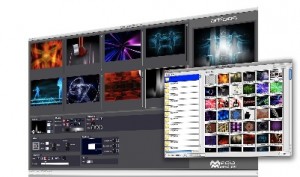 MediaMaster 2.2 now comes with new curved screen technology, it has never been so easy to project video on non-planar surfaces. This new functionality is available as a free upgrade to all user of MediaMaster Pro 2.
MediaMaster 2.2 now comes with new curved screen technology, it has never been so easy to project video on non-planar surfaces. This new functionality is available as a free upgrade to all user of MediaMaster Pro 2.
MediaMaster is a software solution for professional control of real-time video and effects that has been specifically developed for desk operators and lighting designers.
MediaMaster Pro will turn any powerful computer into a full fledged professional media server capable of running live or programmed HD video shows in sync with music and light.
More than simply supporting curved screen functionality, the new geometry correction also allows you to correct a single projector mounted in those difficult places where standard keystone correction is not effective. It will also harmonise the output from several projectors which cannot be installed at the same distance or angle to a curved screen.
The geometry correction operates by transforming the output visuals of MediaMaster and so works on top of both MediaMaster Simple and Fixture mode. A test pattern is available to help precisely align the real-time video content over non-planar or curved screens. Edge blending can be edited globally, or individually for either side of each projector.
MediaMaster retains all it’s simplicity and user-friendliness, so the operator continues to work in the same way as before. The geometry correction module only acts on the played visuals and is activated with a simple setting in the application preference window. The output resolution is limited only by the video card used and is compatible with, for example, the Radeon™ HD 5870 that offers 6 outputs.
The geometric correction itself is very flexible in relation to the number of control points that can be used and the type of correction required: linear, curved or nurb. The displacement can be coarsely moved with the mouse and finely adjusted, pixel by pixel, with the arrow keys of the keyboard.
MediaMaster 2.2 also offers several other improvements, such as better support for multiple monitors. While still running effortlessly on Windows XP and Mac OS X, MediaMaster 2.2 now makes it possible to work with multiple monitors on operating systems that do not support spanning, such as Windows 7 and Windows Vista.
Several new effects have been added including Old Movie, Iris and Geometric Cylindrical Distortion. Other minor enhancements have been made and are documented in the change logs available in the release notes.
One final piece of good news: all the new, sleek, super-functionality of MediaMaster 2.2 is available at a fraction of the cost of other media servers, making ArKaos MediaMaster the most affordable media server software on the market.
Learn more about the latest version of ArKaos by visiting their website at www.arkaos.net.
LatestHeadlines
- Upgrading Your Toolbox: City Theatrical DMXcat-E and DMXcat Multi Function Test Tool
- Claypaky Bringing Back the Sexy to Par Cans with the Midi-B FX
- Ayrton Evolves the Cobra, the Cobra2 Developed for the US Market
- MA Lighting Intros grandMA3 onPC Fader Wing and DIN-Rail Nodes
- Live Events LEVL Up Fest: A Festival to Aid our Industry
